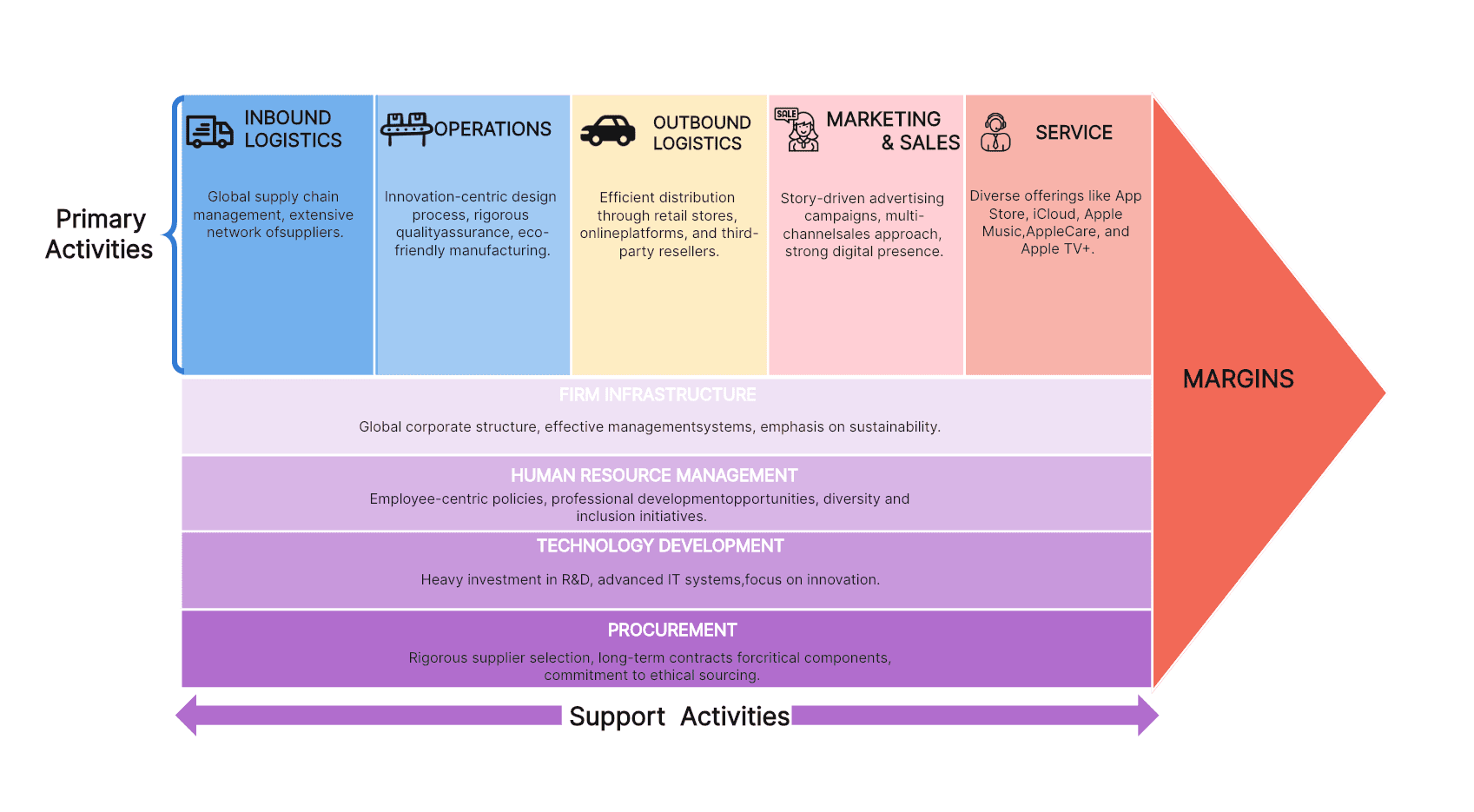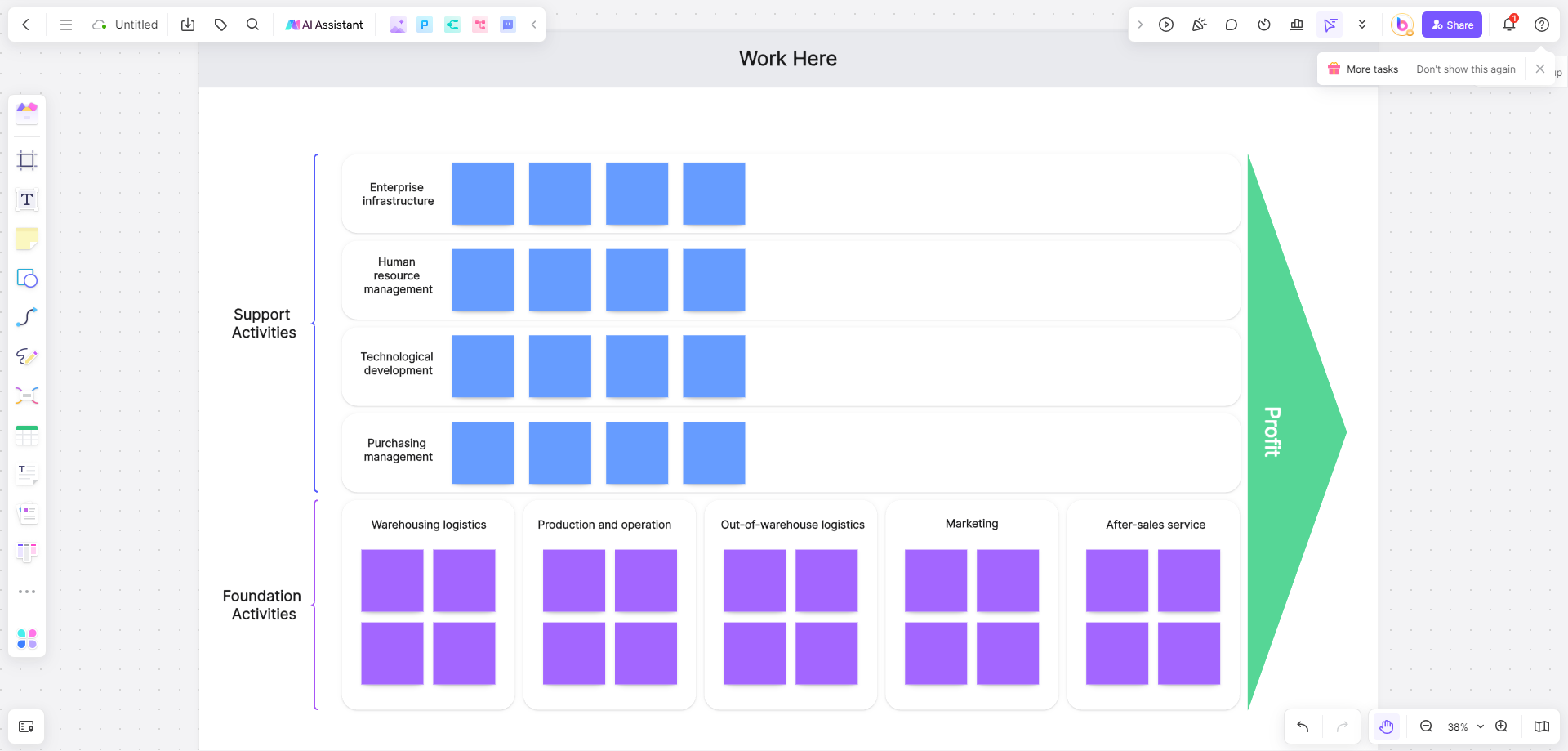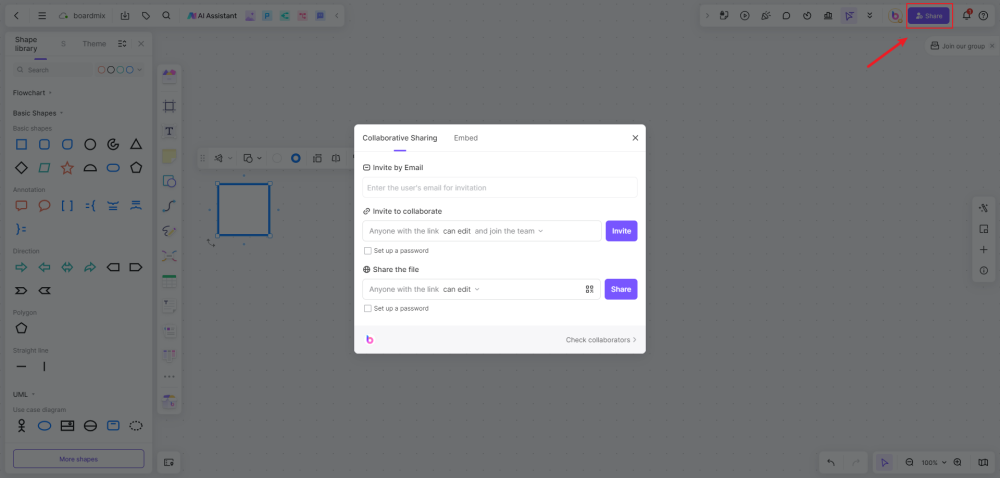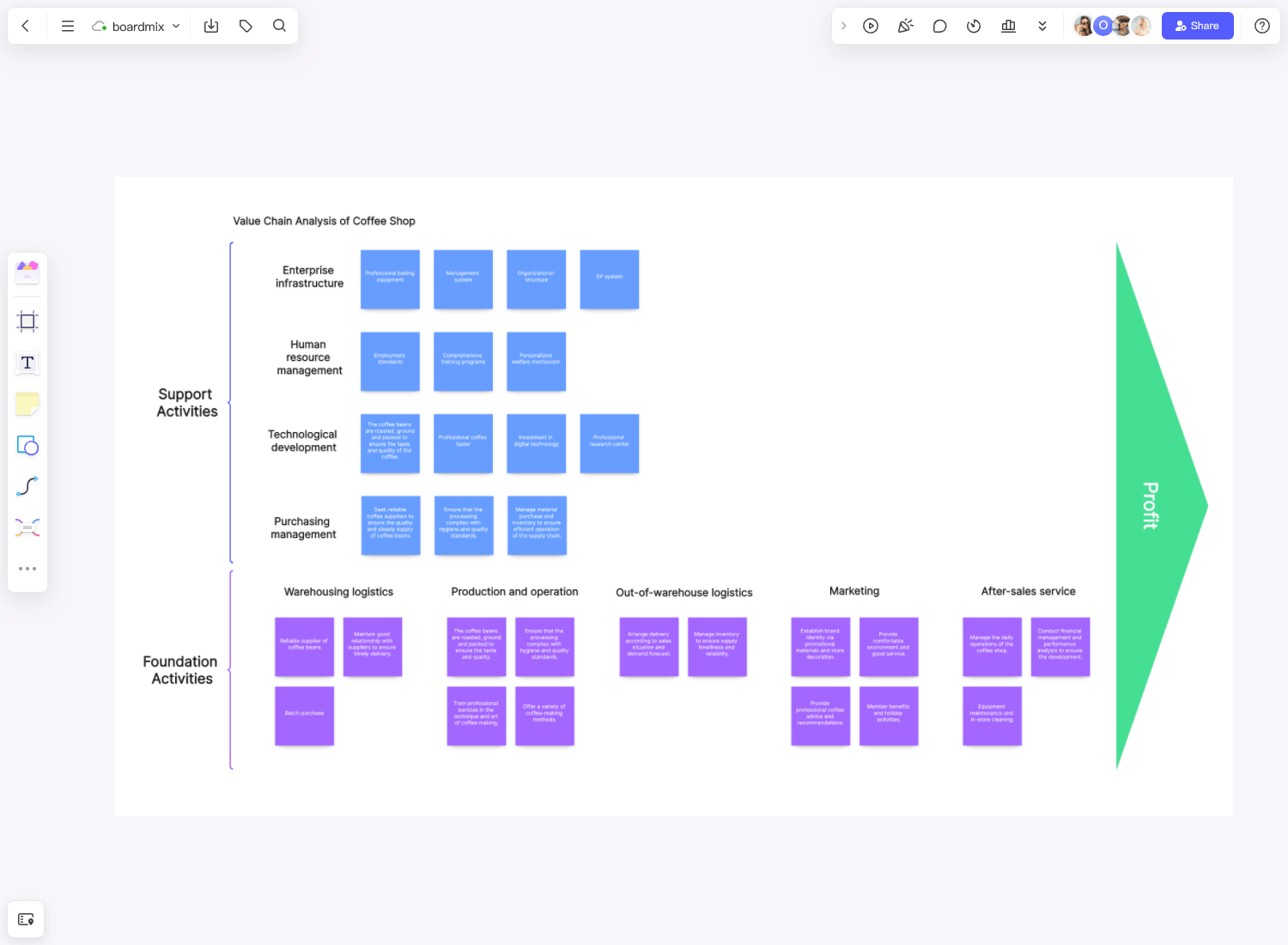About the Value Chain Template
Definition of Value Chain Analysis
Businesses generating greater value with every sale are better positioned to gain profit than those that produce lesser value. Companies must understand the value chain to know how much value their business creates.

Value chain refers to the different business initiatives and procedures involved in creating a product or executing a service. It consists of multiple phases of a product's life cycle, like sales, research, development, and all other essential factors.
Importance of Value Chain Analysis
Most businesses and organizations adopt the value chain template to explore ways to improve their competitive advantage. The value chain model allows you to determine costs, outshine competitors, look for activities that will add the most value, and improve your customers' product and service value.
As you already know, building a service or product can be costly, so having the right tools and strategies will spare you from spending more than what is expected.
Purpose of the Article
In most cases, your business must perform a value chain analysis to ensure you are introducing the right services and products to your target market. This article is your guide and could be used as a reference as you plot your value chain template. The process of creating a value chain analysis is complex, so the points discussed here will come in handy.
Overview of the Value Chain Template
Definition of Value Chain Template
Michael Porter, a Harvard Business School professor, first coined the template. It was then called Porter's Value Chain Model, which guides teams as they evaluate business activities to secure a competitive edge over other companies.
Components of the Value Chain Template
The Primary Activities section is one of the main components of the value chain template. This refers to the aspects that go straight into the execution of a service or the creation of a product. These aspects include the following:
- Inbound logistics. This involves warehousing, receiving, and inventory management of raw materials and other components.
- Operations. You can place the processes to transform raw materials into a finished product here.
- Outbound logistics. This includes processes like sorting, packaging, and shipping.
- Marketing and sales. Pricing strategy, promotion, and advertising comprise this section.
- After-sales processes. This involves training, installation, repair, customer service, and quality assurance.
Meanwhile, the Secondary activities component helps the processes in primary activities to be more efficient. They generally create a competitive advantage. These include the following elements.
- Procurement. These activities are associated with sourcing equipment, raw materials, components, and services.
- Technological development. This includes product design, process development, and market research.
- Human resource management. This revolves around processes concerning the human workforce, including training, hiring, recruitment, compensation of employees, and retention.
- Infrastructure. You can place the company's management and overhead in this section, like planning and financing.
Benefits of the Value Chain Template
Businesses have adopted the value chain template in their operations. This shows the diagram's effectiveness in creating valuable customer products and services. Using the value chain analysis, your team can:
- Back-up essential decisions on various business activities
- identity ineffectiveness and make the corrections
- Understand the responsibilities and relationships between different elements of your business
- Lowering expenses and optimizing efficiency
- See in which aspects your business is succeeding
Value Chain Templates in Boardmix
Boardmix emerges as an innovative platform that offers a ready-made template that streamlines the initiation of feedback sessions, creating an environment conducive to growth and progress within organizations. Its transformative capabilities position it as a one-stop solution, revolutionizing the way feedback is conducted and utilized.
Amazon Value Chain Analysis Example

Amazon, a multinational conglomerate specializing in e-commerce, cloud computing, digital streaming, and artificial intelligence, plays a significant role in the global market. It's a force to be reckoned with, achieving record-breaking revenue figures yearly. This remarkable achievement can be credited to their sophisticated value chain. This comprehensive analysis will scrutinize the primary and support activities of Amazon’s Value Chain, including its logistics, marketing strategies, and overall infrastructure.
Apple Value Chain Analysis Example

Understanding the intricate workings of Apple’s value chain can unlock profound insights into the company's success. This comprehensive analysis delves into the mechanics behind one of the world's most successful corporations. From procurement to technology development, we will reveal how each element of Apple’s value chain contributes to its overall growth and sustainability.
Procurement Example

Procurement activities within a value chain analysis example pertain to sourcing goods that are cheap, efficiently accessible, and high-quality. An excellent example of this is the Walmart chain, which is large enough to be able to negotiate effectively to receive goods at low prices for customers.
Step-by-Step Guide for Using the Value Chain Template
Identify the Primary Activities
Some elements under the primary activities have already been mentioned above. However, your team can explore more areas that you think might be an essential element in your value chain template.
Analyze Each Primary Activity
Discuss with your team the scope of every primary activity, as this will be one of the factors on how much cost your company must invest in creating a product or executing the service. For example, if you are gearing to introduce a bamboo toothbrush, you would surely invest in eco-friendly raw materials.
Identify the Support Activities
Some call it secondary activities. The elements here must be specific, as this will tell you the production process's efficiency and the final product's quality.
Analyze Each Support Activity
As you analyze every support activity, remember that the activities must be related to the primary activity. While doing that, examine the value these activities add to the overall process, including the costs.
Identify Opportunities for Improvement
Identifying opportunities from your value chain will depend on the competitive advantage your team is trying to achieve. This means that if your target is to reduce costs, you must assess each activity of your value chain template from the perspective of reducing expenses. Some elements on the diagram might not provide a significant value and could be removed to reduce costs.
Develop an Action Plan
You must cover all the necessary production processes until the service or product is available to your target market. It is also essential to include the timeline for every stage so you can keep track of every process and see whether they are on schedule or not.
How to make a Value Chain in Boardmix?
With the Value Chain Template from Boardmix, planning and executing activities become much more organized, transparent, and efficient. Here is the step-by-step guide on using the AValue Chain Template for free on Boardmix.
Step 1: Log in to Your Boardmix Account
To begin, you'll need to access your Boardmix account. Go to the Boardmix website and enter your login credentials. If you don't have an account yet, you can sign up for a new one for free.

Step 2: Search and Choose the Value Chain Template
Once you're logged in, head over to the Template library. You can find this in the main dashboard. Search for the Value Chain Template and click to use it for free.

Step 3: Customize and Edit Your Value Chain
Now that you've chosen the template, it's time to customize it according to your needs. You can use shapes, lines, drawing pens, icons, and other tools to decorate your template. The Value Chain template comes with several sections that you can fill out.

Step 4: Save Your Work, Share and Collaborate
When customizing your Value Chain Template, Boardmix autosaves your progress, but it's good practice to manually save before exiting.
Next, share your activity plan to collaborate with your team. Click on the "Share" button on the top right corner of the screen, copy the sharing link, and send it to anyone whom you want to collaborate with. People can join this file to edit and collaborate on this file in real-time by clicking this sharing link. We encourage your team to leave comments, suggest edits, or ask questions online so you can adjust it in time.

FAQs about Value Chain Analysis
What is the significance of Value Chain Analysis?
Value chain analysis is a diagramming tool that transforms your products and services from an idea to a reality. A well-made analysis allows businesses to provide the most value of products for the least possible costs.
What are the different types of value chain analysis?
Cost advantage is one of the two kinds of value chain analysis. This approach deals with streamlining processes and cutting production costs to increase profitability. Meanwhile, differentiation is about adding value by providing high-quality and unique products or services that set your company apart.
What are the key elements of the value chain?
Generally, there are two key elements on the value chain template - primary activities and secondary activities. Each element plays a significant role in ensuring an ideal service or product for a specific target market.
What are the common challenges in executing value chain analysis?
One of the common drawbacks of the value chain analysis is teams might get lost in looking at broader strategic aspects. Since you focus more on the micro details of every component, you might lose focus on the interrelation of all the activities. This is why value chain analysis must be a collaborative effort so there will be members to see the broader spectrum of where the production process is going and if it gears towards the ultimate goal of the analysis.
What are the benefits of using Value Chain Analysis in an organization?
Efficiency is one of the apparent benefits of having a value chain analysis. However, this tool also promotes collaboration among team members in an organization. Looking at the template, it is not only the sales and marketing department that has to work but other departments in the company.
Can Value Chain Analysis be used for small businesses?
Yes. All types and sizes of businesses use value chain analysis. As you already know, companies have different processes, and using a value chain allows them to study, assess, and improve these processes to deliver the most value for their products. Furthermore, as you create your value chain template, it's much better to use diagramming software. This way you can allow access and authorize people to make revisions to your chart if necessary. The modifications can even be done remotely.












